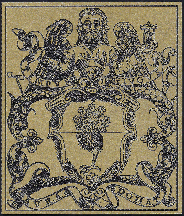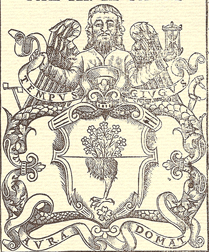HIST AWARD FOR OUTSTANDING ACHIEVEMENT IN THE HISTORY OF CHEMISTRY
Plaque Description
The HIST Award plaque consists of four parts:
- A 12” x 9” felt backed wooden board painted black.
- A 3.5” x 3” x 0.25” magnesium reverse etched gold plate.
The design, in gold, is a copy of the design on the frontispiece
of the Plicto de Larte de Tentori che Insegna Tenger Pani Telle Banbasi et Sede si per Larthe Magiore come per las Comune by Gioanuentura Rosetti, published in Venice in 1548. Sidney M. Edelstein and Hector C. Borghetty published a translation of the 1548 edition (The Plichto of Gioaventura Rosetti Instructions in the Art of the Dyers which Teaches the Dyeing of Woolen Cloths, Linens, Cottons, and Silk by the Great Art as Well as by the Common MIT Press, 1969). In the Introduction they state "Rosetti's Plichto is the first basic printed book on dyeing."

 Frontispiece from Plichto(1548)
Frontispiece from Plichto(1548)
showing only the relevant image - A 3” x 0.625” x 0.25” magnesuim reverse etched gold plate with the name of the award engraved on it.
- A 4.5” x 4” x .25” engraved with the recipient’s name, an explanation of the nature of the award, and the name of the presenter, the History of Chemistry Division of the American Chemical Society.
An image of the award presented to William Newman, the 2013 HIST Award Winner.
The award is manufactured by the Stellar Kent Corporation.

